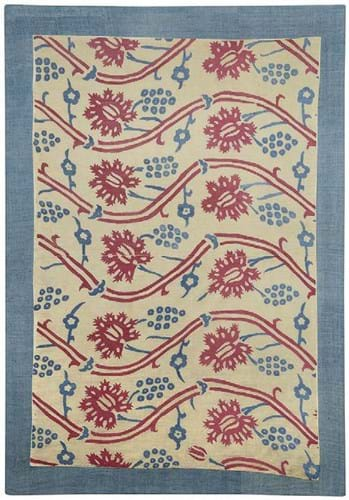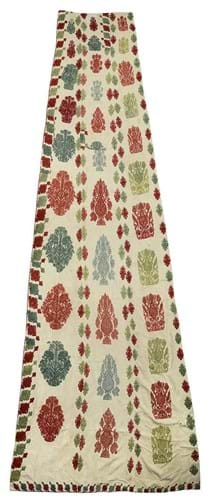
Large Ottoman silk-embroidered linen fragment, Turkey, late 17th century, from the collection of Philippa Scott, which featured at Oliver Forge & Brendan Lynch’s exhibition.
The show ran from October 23-27 at the dealers’ Pall Mall gallery, and Greek textiles were an area of popular interest.
Possibly from the same bed tent, the two textiles date to the 18th century and come from the Dodecanese Islands in the Aegean. Both are of tapering form and embroidered on a cream cotton ground in Greek twisted cross-stitches with variants of the ‘vase’ and ‘king’ patterns in red, pale blue and green floss silks. Both sold for less than £10k.
Collections of Greek textiles became popular among 19th and early 20th century archaeologists at the British School in Athens who visited the Aegean Islands to explore ancient sites. More recently they have been the focus of exhibitions at the Ashmolean Museum and the Fitzwilliam Museum.

Rhodian silk-embroidered linen curtain from a bed-tent (sperveri) Dodecanese Islands, 18th century, from the collection of Philippa Scott, which featured at Oliver Forge & Brendan Lynch’s exhibition.
The textiles in the show were from the estate of the late Philippa Scott (1946- 2023), a Scottish collector born in India. According to the catalogue: “Dressed in a Fortuny gown or a l’Ottomane, as an accomplished cook she entertained guests with style and humour in her Notting Hill flat, which was filled with Iznik pottery, Greek and Turkish textiles, a vast library and, to set the scene, superb Ottoman murals painted in the early 1980s by Alex Davidson.”
Another highlight from her collection at the show was a large Ottoman silk embroidered panel with a design of red and blue flowering vines. It sold for more than £10,000.














